After 45 games (as of 5/2/21) of logging every single Lakers post up over recent months, it’s time to share the data. The Lakers have a post up problem. It’s hard to unsee once you notice it watching games, but subtle enough that I haven’t seen it covered by a single Lakers media source all season (other than the Lakers Exceptionalism Pod I co-host). Yet it’s costing the Lakers points every single game.
Check out the dashboard here.
“HELP”
“HELP HELP HELP,” we can hear yelled daily at this point when watching Lakers games. And defenses do, because they need to.
That has created a constant game of cat and mouse this season for LA’s post offense. Defenses know you can’t leave these players alone to operate in true 1v1 situations. Here’s how efficient each higher volume Lakers post player has been in those scenarios:
- LeBron: 1.26 points per possession. Insanely good.
- Trezz: 1.14 PPP. Stupid good.
- AD: 1.07 PPP. Very, very good.
- Drummond: 0.91 PPP. Not too good.
These guys have been lights out if you truly leave them alone. That’s why last playoffs, and this regular season, we’re seeing defenses bring extra help to slow down LA’s high volume post attack (3rd in volume behind Denver & Philly).
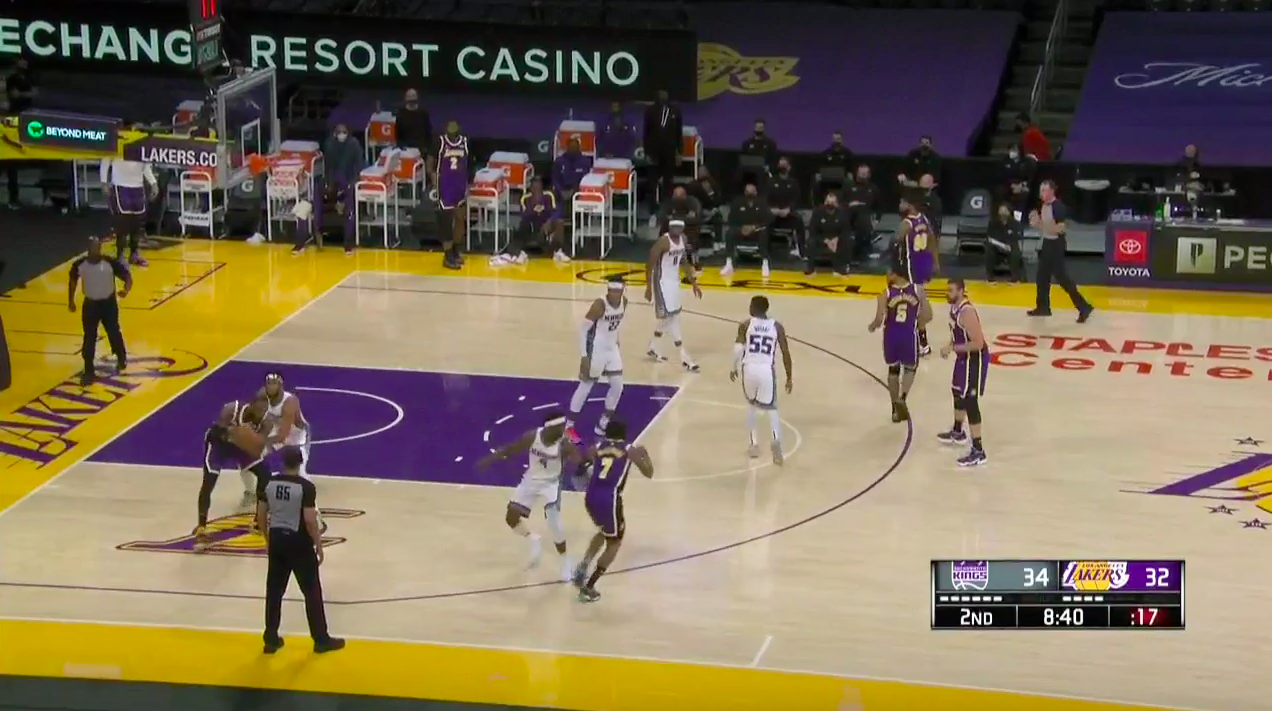
Take this possession, for example. LeBron is left alone, and that defender has no shot at stopping him. There’s no double and no digs coming. Just a true 1v1 situation, where LeBron scores here on the hook, but easily could’ve jump stopped and used an up and under move if the defender had committed to stopping the running hook.
Kieff (0.82 PPP) and Gasol (0.76 PPP) have been less dominant, and defenses thus send far less frequent extra help than they do against some of LA’s other post players.
Overall, the Lakers score 1.07 points per possession on post ups, including pass outs (as everything will in this article), when left alone in a true 1v1. But from those 45 games of tracking, this is only happening on ~49% of post ups.
Not Countering Help
From that last section, we know extra help is coming 51% of the time. And that’s for the team overall. For LeBron it’s 65% of the time. For AD, 60%. Teams do not want these guys playing 1v1.
Basketball is a numbers game. A simple one. If you get a 2 on 1 in transition, you should score efficiently. If you have a 1 on 2, you’re better off pulling the ball out and setting up the offense.
This post situation is similar. If the defense brings a second defender, ranging in commitment from standing in the way from you driving middle to doubling hard, you have a numbers disadvantage on-ball. But that means off-ball you have a 4v3 to exploit.
For as much as we’d love to pump up LeBron and AD for being superhuman players, they still play a hell of a lot better when they aren’t double teamed.
When help comes and is not countered, here are the efficiencies for those high volume post players:
- LeBron: 0.74 points per possession.
- Trezz: 0.44 PPP.
- AD: 0.90 PPP.
- Drummond: 0.77 PPP
Each of these guys, and the Lakers offense as a whole, are very clearly worse attacking 1v2 than they are 1v1. Overall as a team LA’s efficiency is 0.73 points per possession.
And this is including pass outs! Again, there are no organized counters being used here, but we see plenty of LeBron passing out of a 1v2 with a skip pass. The issue with those scenarios is that it’s not hard to recover to shooters standing still. That’s middle school shell defense basic practice caliber stuff.
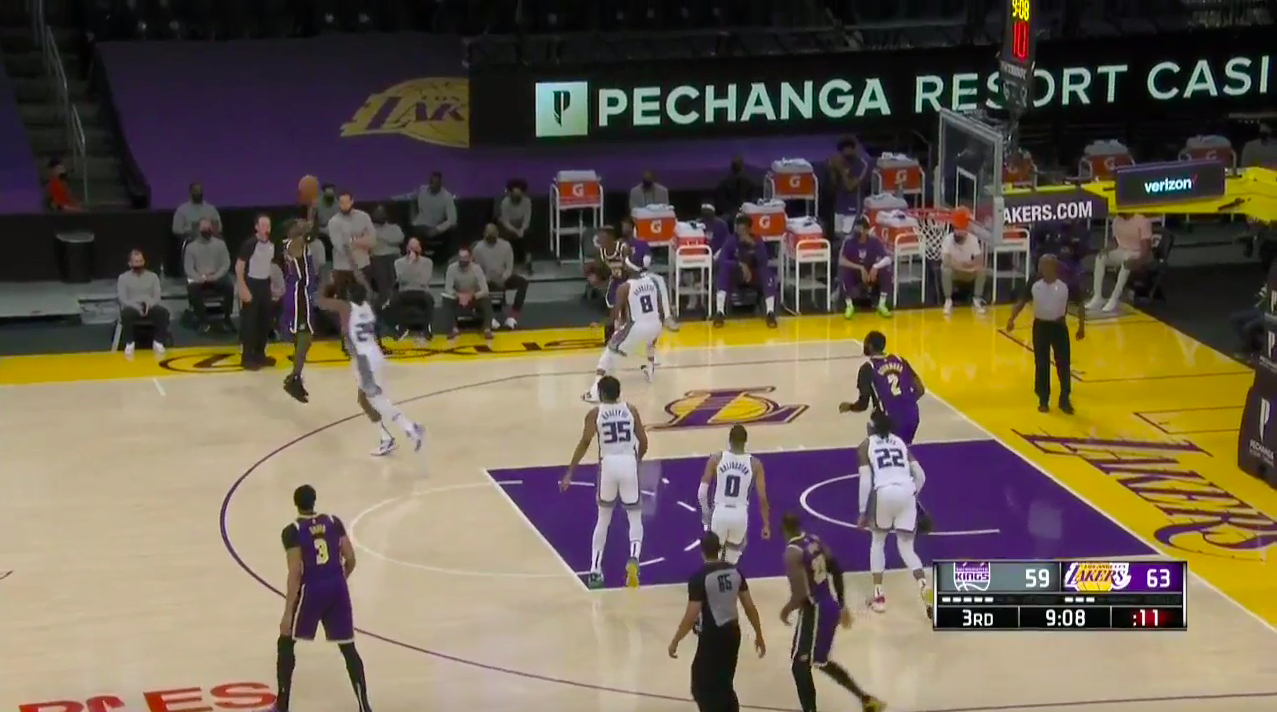
Here, Drummond almost screens the defender that ultimately turns KCP’s 3 into a contested one. But he doesn’t, and the defense completely nullifies LeBron’s post-up and only pays a contested above the break 3-point attempt for that effort. That’s a losing battle for LA.
If LA had more elite driving options to catch and attack a closeout, or shooters able to knock down semi contested shots at elite rates, this might be a different story. But with these Lakers shooters, you’re aiming for open 3s. Not contested 3s.
From this, I think we can agree it is bad when the Lakers ignore opponents bringing a 2nd defender, either by try to power through 2v1s or by playing hot potato time bomb on the weak side as the defense recovers to the skip pass.
What’s wild to me is that the team is only even trying to counter extra help 34% of the time it comes. 38% of the time the help exposes the strong side and 22% when it exposes the weak side. The first step is recognition and trying to counter the help.
Countering Help Well
You’ll notice that on the dashboard you’ll see verbiage like “Correct” and “Incorrect.” We’re right back to that numbers game with this. If the defense puts 2 defenders on-ball and is giving up a 3v2 weak side, that’s where the numbers advantage is. If the help leaves the strong side in a 2v1, that’s the spot to target.
When the Lakers do recognize they need to counter and try something, it’s usually correct. 62% of the time. It’s correct 76.5% of the time when the help exposes the strong side, and 54% of the time when the help exposes the weak side.
Not surprisingly, we see the Lakers post offense soar in efficiency when picking correctly and target 2v1 and 3v2 situations as their battlefield to exploit.
- LeBron: 1.42 points per possession.
- Trezz: 1.79 PPP.
- AD: 1.45 PPP.
- Drummond: 1.98 PPP!!
As a team, the Lakers score 1.48 points per possession when “correctly” attacking the vulnerable area the defense presents by sending extra help to the post up. That’s some prime LeBron attacking you in transition efficiency right there.
Here’s an example. Pause the clip with 11:28 left in the quarter and find the numbers advantage.
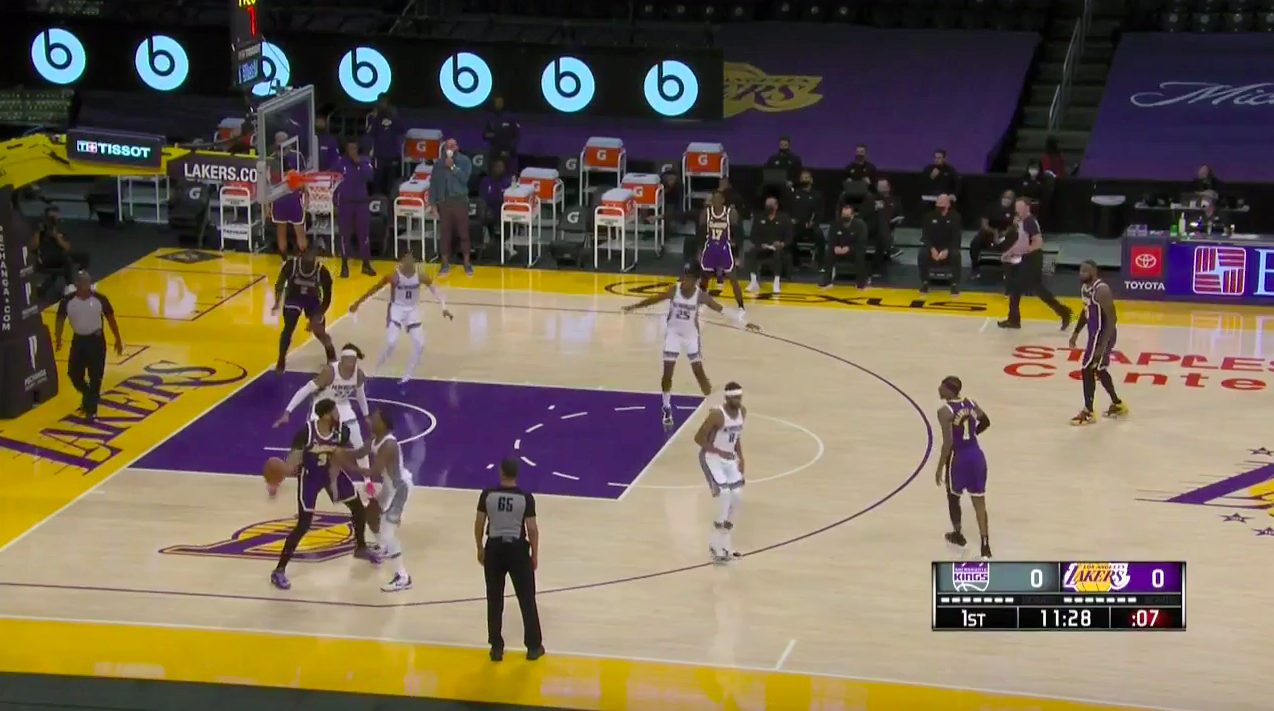
2 on-ball as baseline help comes, Drummond with a guy on him, and a 3v2 on the perimeter among the remaining players. LA cuts the middle of those 3 guys to maximize the spacing of the remaining 2 shooters. LeBron cutting pulls both defenders to him in this instance, but even if he only took 1 with him we’d see a wide open 3-point shooter either in KCP or Schröder. If LeBron wasn’t covered, he’d get a highlight dunk out of the play.
Here’s a second example. Where’s the advantage?
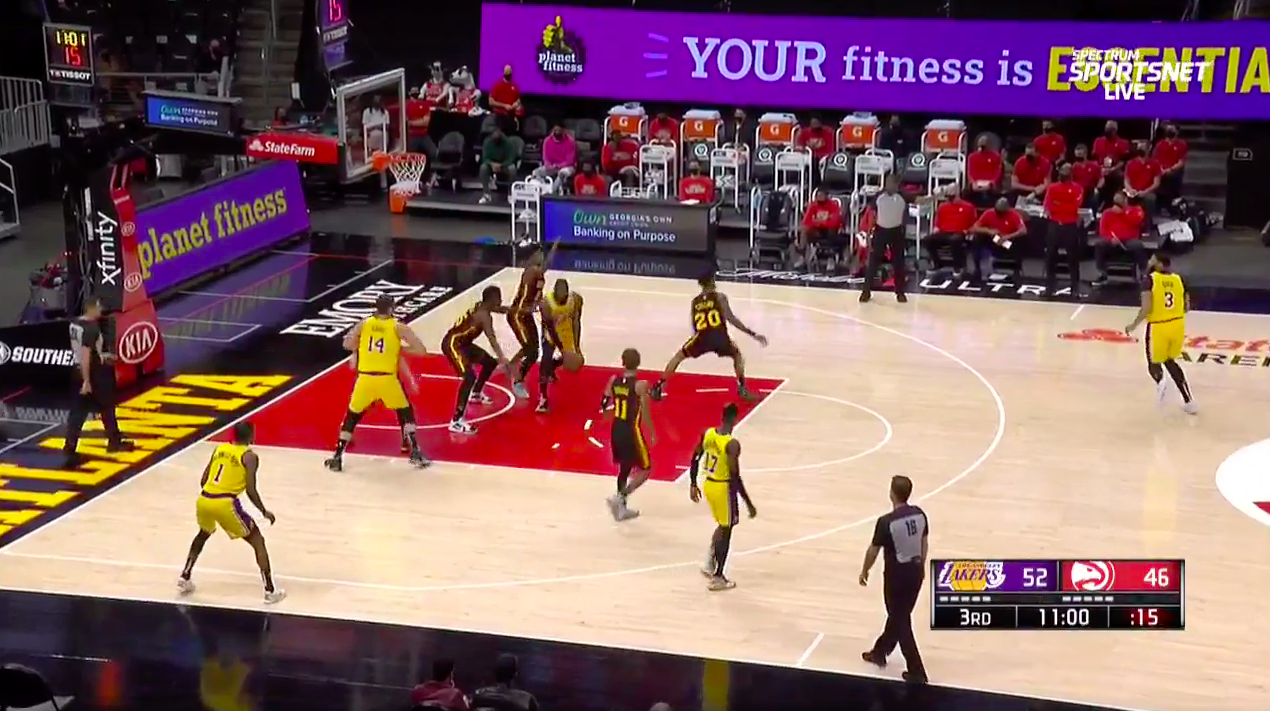
Weak side! And this time, we see Gasol completely wall off the defender who would normally close out to the opposite corner with a “pin-in” flare screen. LA has scored 1.4 points per possession using pin-in flares as counters attacking numbers advantages.
That same kickout to the opposite corner can be a wide open 3, a contested 3, or covered well enough there’s no shot available at all. It takes the coordination between LeBron and Gasol to have that screen set to make the shot a wide open one.
From watching all 500+ of these clips, I can say with confidence I’ve seen no one set more pin-in flares than Gasol.
All in all, the Lakers offense kicks butt when it counters correctly. Including missed shots, miscommunication, and poor execution, it’s still very clearly been generating high quality shots consistently and has translated to high efficiency.
Unfortunately for LA, they’re only countering and doing so correctly on 29% of the plays where the defense leaves a vulnerability to attack on the strong side (usually with a cut) and 17.5% for vulnerabilities on the weak side. Frequency matters!
The Lakers already use the right counters. They just don’t try to use them
Countering Help Poorly
There are also times where the Lakers make bad decisions. They try to counter the help, but ways our coded in (and double checked!) logic would say is “incorrect.”
What that means is that the defense gave the Lakers a 2v1 or 3v2 off-ball, but they instead opted to attack with a counter towards a part of the defense where the Lakers didn’t have a numbers advantage.
This is happening 38% of the time LA tries to counter (23.5% vs strong side vulnerable help and 46% vs weak side vulnerable help). To me, that’s way too high.
Sometimes, this is because the defense brings help from an area of the court but rotates behind it to cover the weakness. For example, watch this clip:
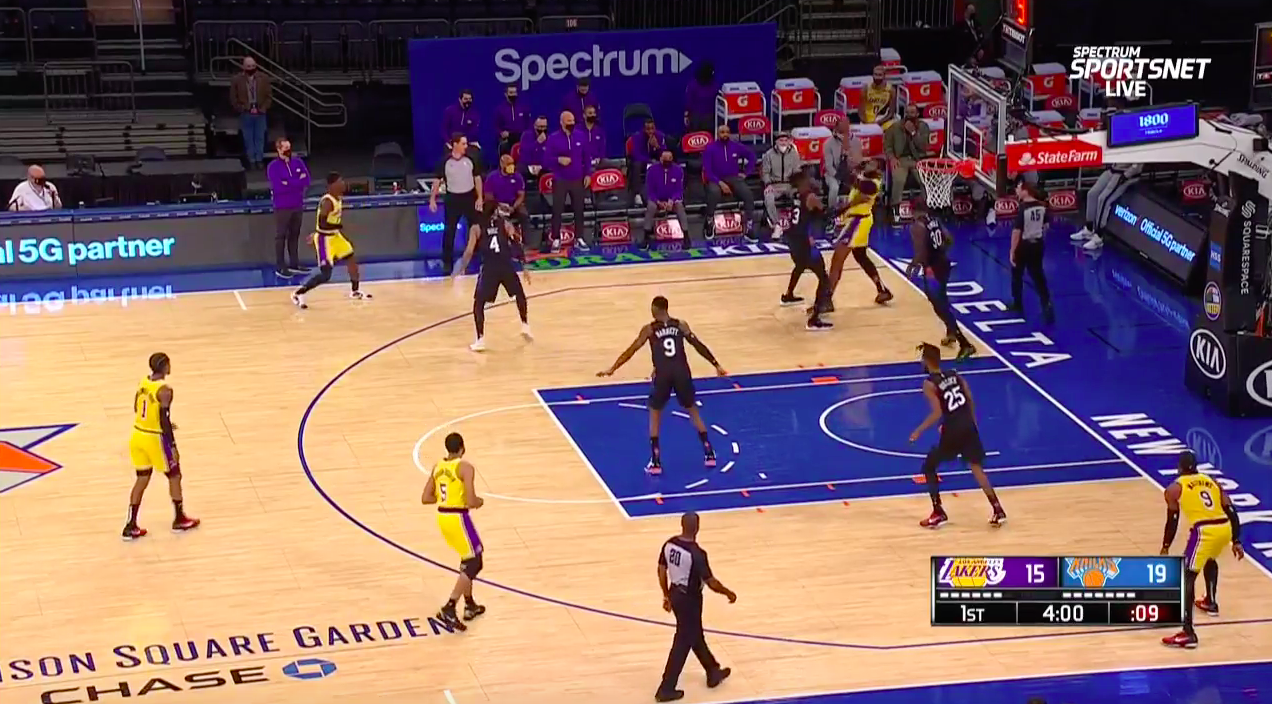
There’s no counter attempted here, but did you notice the defense’s rotation? Randle came from the baseline to help on Drummond. But Randle’s man wasn’t open, because Bullock “bumped” down to take him. RJ Barrett defending 2 shooters was, because of the bump, the weak area of the defense.
If LA had tried to cut Wes into that bumping defender, that’s likely a turnover and an incorrect counter. If LA had THT set a pin-in flare for KCP, that’s a correct counter. But the post player and the off-ball players need to read the defense well for this to work.
The most frequent incorrect counter we see is when the defense digs from the strong side and either 1) also helps from the baseline, or 2) bumps over a perimeter defender to take away the strong side pass out or cut.
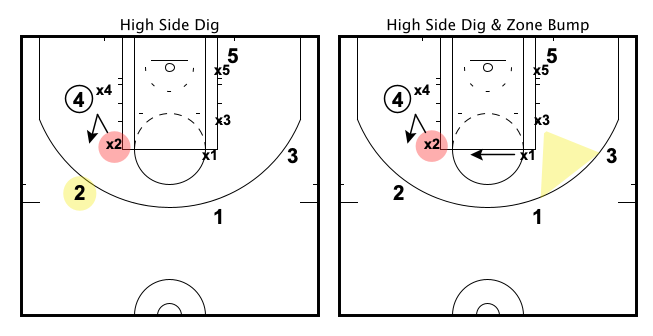
Against a dig or double on the strong side, the Lakers often cut the player being helped off of. The defense sending a defender into the paint to take away that cut means that at best, it’s not open and the offense wasted some time.
At worst, it’s a bad pass turnover and runout on the other end. A lot of the time in the middle of those outcomes is the offensive player driving towards the rim from the post into a loaded up paint from the cut and extra defender.
Not surprisingly, these attacks don’t work frequently. LA scores 0.45 points per possession on incorrect counters, and turns the ball over TEN TIMES as frequently on incorrect counters as they do on correct counters. We’re not working with humongous sample sizes here, but it’s obvious on film why attacking numbers advantages works and why attacking disadvantages doesn’t work.
Overall
This single improvement fixes a substantial portion of LA’s half court offensive woes. It helps LA’s superstars look like superstars, better sets up the team’s shooters with more open shots, and is well within grasp of implementation. Last playoffs we saw LA lean on their post and iso offenses more, not add new set plays. So why not focus on a fix to help those key areas?
For me, any Lakers playoff series loss will include several key elements. The 3-point shooting performing poorly is one. This is another. Fix this, and it becomes way harder to beat the Lakers in the playoffs. Don’t fix it, and defenses can feel much more comfortable not being able to match up with LeBron/AD and can switch actions with more confidence, knowing they can fall back on extra help to clean up the messes creating in those instances.
So what do you say? Is a multiple point Offensive Rating boost for installing 0 new plays worth a new point of emphasis in film sessions? I’d say so.
If you haven’t already, go check out the dashboard of data here.
Now let’s cover some FAQs I’m anticipating you might have.
What’s the best way to take advantage of this as an opponent?
Good question! I’d absolutely be helping as frequently as I can on post ups by LeBron, AD, and Harrell. I’d be sending help that exposes me to those weak side pin-in flare screens, knowing LA’s likely not going to use them. Even better, I’d dig from the strong side briefly as I’m sending that opposite side baseline help, to see if I can bait the Lakers into cutting into the defended paint and clog things up for a post player drive and potentially get a turnover and runout on the other end.
AD is the most resilient to extra help being brought against him, or at least is the one guy with not horrific efficiency when attacking 1v2. This is because so much of his post game is already jumper oriented and he’s a pretty tall guy. For him, you want to play him on his high side on-ball with the help coming baseline into his blind spot. Play him straight up on-ball with help from the baseline and he’ll face up and see what’s going on. Make him spin into the help and he’ll force up bad shots and turn the ball over.
Work pre-catch by fronting or “three quartering” him on the high side to make post entries be lobs taking him to that blind back side are also smart (Washington did this recently).
Is Vogel Just Hiding Secrets?
This is a go-to excuse for anytime the Lakers make any decision that isn’t optimal. No, this isn’t hiding the nuclear launch codes.
If they’re hiding the answers, they’re doing a poor job. LA has shown on film every counter I’d want to deploy against these types of help defense.
The issue is frequency, not creativity. And it was last playoffs as well (when they had a similar issue).
How Do the Lakers Fix This? What’s the Potential Impact?
To go from *this* to awesome, all LA needs to do is counter more frequently (currently at ~35%) and counter more accurately (currently 62% accuracy).
The potential impact from these improvements depends on 1) how frequently they counter, 2) how accurate those counters are, 3) who’s posting up, and 4) how frequently the team is posting up.
From fiddling with these variables, I’d say the team is looking at a post up offensive rating boost of 2.5 to 4.0 points with any real amount of improvement.
And if they’re kicking butt consistently with post ups, they’ll probably post up more. Creating a larger impact. The same way they’ve posted up less in specific games when they struggle to beat specific types of help.
We get to the higher end of that range if LA can counter 75% of the time they face extra help and on 80% accuracy, are posting up ~20 times per game like they have in a lot of games with both LeBron + AD playing, and post ups are going to logical players.
Does Having AD and LeBron Back Fix the Issue?
The opposite, actually. We see LA post up more frequently when LeBron and AD are available. When it’s the Kieff and Trezz show down low, we’ve even seen LA post up in the single digit volumes a few times.
During the injury lull, we’ve seen LA impacted less by this issue because they posting up less, not because they solve the issue.
Higher volume from them playing, along with these two being the two guys defenses are keying in on most with extra help, isn’t a recipe to solve the issue.
The Playoffs: Opportunity or Threat?
This is also an issue I anticipate will hurt the Lakers even more in the playoffs. It did last year. Defenses engage more in the tactical side of basketball during the playoffs.
As a result of that, we saw LA’s post offense drop in efficiency, and go from being 10th most efficient among 30 regular season teams (“Very Good” efficiency label) to 9th most efficient among a far smaller number of Playoff teams.
We’ve also seen defenses help more and more frequently, and in smarter ways. Help exposing LA’s weak side have been most effective, so teams are doing that more. Month over month, we’ve seen key Lakers players face more help and smarter help.
The book it out on the Lakers, and to the point where me publishing an article and dashboard of “here’s a glaring way to shut down LA’s top form of offense” presents far less risk than it did 2 months ago. My eyes were opened to this after doing some scouting work on upcoming opposing teams, then seeing how many of them changed from their normal post defense game plans to exploit LA’s weaknesses.
Other Noteworthy Items
- LA’s isolation offense faced similar issues last playoffs. We saw mismatch after mismatch not abused by normally lethal iso options, because the defense was pre-rotating players to the front of the rim on drives and stunting off of nearby offensive players. This was a key tactic we tracked in early Lakers Exceptionalism Pod episodes.
- The snowball effect of this issue can go both ways.
- Fix it, and suddenly defenses are choosing between giving up 2v1s they know will be attacked or living with LA attacking in true 1v1s.
- Don’t fix it, and we’ll see teams in the playoffs more willing to switch actions and concede perimeter or post mismatches, knowing they can bring extra help and not get burned by those matchup concerns.
- Don’t fix it, and we’ll see teams in the playoffs find more creative ways to give LA 4v3 and 3v2 situations they feel good about LA not exploiting. An example might be putting Rudy Gobert on Caruso/Matthews/Gasol/Kieff if LA goes small and roaming off of them to defend the rim, trusting back end rotations to cover up the numbers advantage conceded to LA.
- If you have a good shot quality model that goes possession by possession, hit me up. We have possessions marked as part of logging, and I’d be curious to see how the shot quality aligns with the results seen in actual efficiency.
Where’d This Data Come From?
Some data is in a box score. Some comes from tracking data. This data comes from actual film logging, done by me and Tim Wijaya. This was an idea derived in our Lakers Exceptionalism Pod Discord. I had suspicions and (not me) Tim was looking for a data project to dig into.
If you’re interested in this sort of thing and want to offer your help, reach out! For Lakers specific items, DM me. For more general basketball data help, also feel free to DM me or email at the site account listed at the top of the home page.
